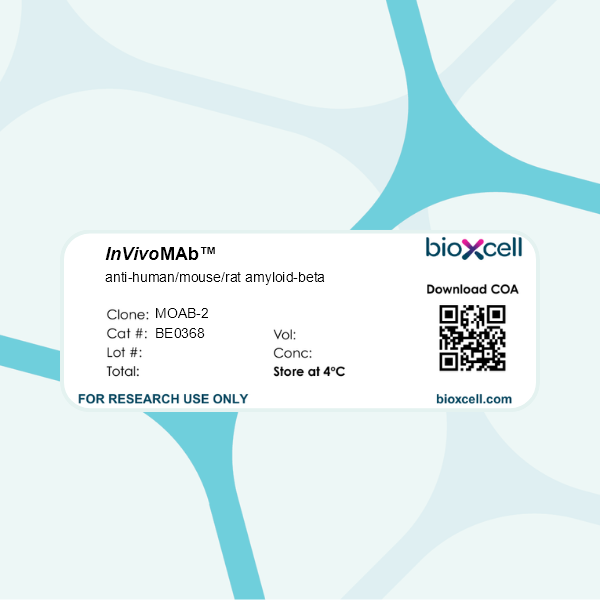InVivoMAb anti-human/mouse/rat amyloid-beta
Product Description
Specifications
| Isotype | Mouse IgG2b, λ |
|---|---|
| Recommended Isotype Control(s) | InVivoMAb mouse IgG2b isotype control, unknown specificity |
| Recommended Dilution Buffer | InVivoPure pH 7.0 Dilution Buffer |
| Conjugation | This product is unconjugated. Conjugation is available via our Antibody Conjugation Services. |
| Immunogen | Human Aβ42 |
| Reported Applications |
Western blot Immunohistochemistry Immunofluorescence Immunoprecipitation ELISA |
| Formulation |
PBS, pH 7.0 Contains no stabilizers or preservatives |
| Endotoxin |
≤1EU/mg (≤0.001EU/μg) Determined by LAL assay |
| Purity |
≥95% Determined by SDS-PAGE |
| Sterility | 0.2 µm filtration |
| Purification | Protein A |
| RRID | AB_2927505 |
| Molecular Weight | 150 kDa |
| Storage | The antibody solution should be stored at the stock concentration at 4°C. Do not freeze. |
| Need a Custom Formulation? | See All Antibody Customization Options |
Application References
Western Blot
Immunohistochemistry
Immunofluorescence
Immunoprecipitation
ELISA
Youmans, K. L., et al (2012). "Intraneuronal Abeta detection in 5xFAD mice by a new Abeta-specific antibody" Mol Neurodegener 7: 8.
PubMed
BACKGROUND: The form(s) of amyloid-beta peptide (Abeta) associated with the pathology characteristic of Alzheimer’s disease (AD) remains unclear. In particular, the neurotoxicity of intraneuronal Abeta accumulation is an issue of considerable controversy; even the existence of Abeta deposits within neurons has recently been challenged by Winton and co-workers. These authors purport that it is actually intraneuronal APP that is being detected by antibodies thought to be specific for Abeta. To further address this issue, an anti-Abeta antibody was developed (MOAB-2) that specifically detects Abeta, but not APP. This antibody allows for the further evaluation of the early accumulation of intraneuronal Abeta in transgenic mice with increased levels of human Abeta in 5xFAD and 3xTg mice. RESULTS: MOAB-2 (mouse IgG2b) is a pan-specific, high-titer antibody to Abeta residues 1-4 as demonstrated by biochemical and immunohistochemical analyses (IHC), particularly compared to 6E10 (a commonly used commercial antibody to Abeta residues 3-8). MOAB-2 did not detect APP or APP-CTFs in cell culture media/lysates (HEK-APPSwe or HEK-APPSwe/BACE1) or in brain homogenates from transgenic mice expressing 5 familial AD (FAD) mutation (5xFAD mice). Using IHC on 5xFAD brain tissue, MOAB-2 immunoreactivity co-localized with C-terminal antibodies specific for Abeta40 and Abeta42. MOAB-2 did not co-localize with either N- or C-terminal antibodies to APP. In addition, no MOAB-2-immunoreactivity was observed in the brains of 5xFAD/BACE-/- mice, although significant amounts of APP were detected by N- and C-terminal antibodies to APP, as well as by 6E10. In both 5xFAD and 3xTg mouse brain tissue, MOAB-2 co-localized with cathepsin-D, a marker for acidic organelles, further evidence for intraneuronal Abeta, distinct from Abeta associated with the cell membrane. MOAB-2 demonstrated strong intraneuronal and extra-cellular immunoreactivity in 5xFAD and 3xTg mouse brain tissues. CONCLUSIONS: Both intraneuronal Abeta accumulation and extracellular Abeta deposition was demonstrated in 5xFAD mice and 3xTg mice with MOAB-2, an antibody that will help differentiate intracellular Abeta from APP. However, further investigation is required to determine whether a molecular mechanism links the presence of intraneuronal Abeta with neurotoxicity. As well, understanding the relevance of these observations to human AD patients is critical.

